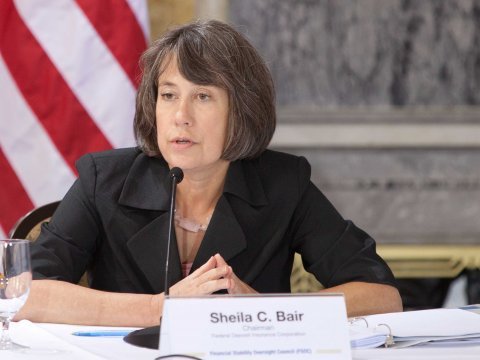Former Federal Deposit Insurance Corporation (FDIC) chair Sheila Bair was given a platform on Yahoo! Finance to share her thoughts on the world’s most popular cryptocurrency, bitcoin. While she trucks in regulatory speak, some of her ideas might surprise crypto enthusiasts.

Bitcoin’s Value is Psychological
Agreeing the current price run-up is indeed a bubble, the former FDIC chair asks rhetorically what should be done. She alludes to Nobel Prize economist Joseph Stiglitz’ bromide at the digital asset for having no socially useful function, calling for an outright ban. But then she insists “Value — like beauty — is in the eye of beholder.”Ms. Bair was appointed by President W. Bush to a five-year term fro summer 2006 through President Obama’s first term, ending summer of 2011. The FDIC is a Depression-era solution to pool private money into a fund in order to lessen bank runs.

Runs usually occur when confidence is lost in the deflationary aspect of a currency, and folks can see the value dropping; the quicker they get to it and spend it, trading it for something that holds better value, the less they’ll suffer. The FDIC since 2011 guarantees deposits up to 250,000 USD based on that private pool and 100 billion USD credit from the US Treasury. Currently close to 6,000 banks subscribe.Unfortunately, Ms. Bair misses a chance to explain bitcoin and the Bitcoin network underlying it do possess inherent value, as they make it both a token and payment system. Instead, she equivocates, stating: “Since the beginning of commerce, humans have assigned value to things of no readily-apparent intrinsic worth. Particularly in the case of mediums of exchange, aka currency, we assign value simply because those with whom we transact do so as well. Whether it is the cowry shells of ancient India or the thin green pieces of paper many of us still carry in our wallets today, worth depends more on psychology than physical attributes,” she argues.

Loss is the Best Teacher
With the best of intentions, she rifles through use cases where faith in government fiat failed, such as in Germany and Southeast Asia. She does acknowledge the “strong allure” of peer-to-peer transacting and how “unlike fiat currency, its finite supply and purposeful constraints on the pace of ‘mining’ make it attractive to many as a store of value, similar to gold.”
She attributes bitcoin prices to mania, but cautions government against feeding the frenzy. Banks participating in FDIC protection and services should not be allowed to participate, she warns. And while that would be an unpopular decision in the short run, it actually might win broad approval from bitcoiners who fear banks and their meddling.

Ms. Bair lauds the New York license, and believes Cboe and CME futures contracts will ultimately bring more regulation (to her mind, stability) to the digital asset by the very nature of sharing information with crypto exchanges. She is also appreciative of the SEC’s more aggressive moves against initial coin offerings.
She too uses the blockchain buzzword (and she reveals she is part of a business dealing in the tech), and it’s ironic because of the usage of that word seems to be the real bubble. Businesses simply attaching blockchain to their names have seen crazy rises in valuations. Finally, she saves her soundest advice for last: “The best discipline for bitcoin speculation is the recent fall in price by one-third.”